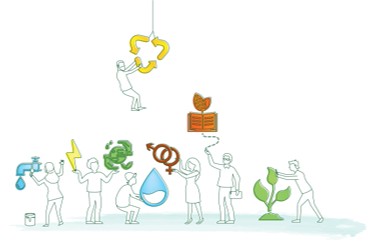Enterprise Profile
Enterprises that fall into this category have a standardised product and flexible operation to meet surge demands of businesses at scale (e.g., seasonal change, weather, conflict). Instead of aiming for stable and recurring revenues, these enterprises have a volatile revenue stream and are able to handle it operationally.
Business Model Features
The business model primarily focuses on offering products that aim to facilitate the distribution or treatment of water. Even though the enterprise offers predominantly standardised and tangible items, it also offers supporting consulting services.
The enterprise’s primary customer group are businesses (B2B), but it occasionally also sells to end-users (B2C) or government agencies (B2G). Unlike typical B2B businesses that focus on stable and recurring revenue from their business customers, the enterprise in this typology offers solutions suitable for flexible demand such as increased irrigation need due to seasonal change; water treatment and distribution for emergency relief; or construction material for stormwater relief.
Context and Environment
The operating context are diverse and depend more on the beneficiaries of the businesses they serve than the enterprise themselves. If the businesses operate in agriculture, the enterprises sell in rural areas; if businesses face a lot of end beneficiaries, it is more likely for them to be in urban areas.
While the solutions the enterprise offers are not restricted to high- and middle-income end users as such, the business clients of the enterprise are more likely to target segments with higher purchasing power. Nevertheless, some enterprises offer specific solutions targeting low income and BoP markets and cooperate with NGOs and government agencies for disaster relief, for instance.
Impact Potential
Many enterprises in this typology offer products, especially in water treatment or distribution, that can be used to extend services or generate impact. Some of them are partners or suppliers of government agencies and NGOs that generate high impact. However, their impact is indirect and realized only through their partners, which makes the additionality and intentionality of the impact difficult to establish.
Potentially relevant SDG Targets
Water-related impact
SDG 6.1 By 2030, achieve universal and equitable access to safe and affordable drinking water for all.
SDG 6.2 By 2030, achieve access to adequate and equitable sanitation and hygiene for all and end open defecation, paying special attention to the needs of women and girls and those in vulnerable situations.
SDG 6.3 By 2030, improve water quality by reducing pollution, eliminating dumping and minimizing release of hazardous chemicals and materials, halving the proportion of untreated wastewater and substantially increasing recycling and safe reuse globally.
SDG 6.b Support and strengthen the participation of local communities in improving water and sanitation management.
Environmental impact
SDG 14.1 By 2025, prevent and significantly reduce marine pollution of all kinds, in particular from land-based activities, including marine debris and nutrient pollution.
Team and Experience
The enterprise in this typology offers solutions primarily to business customers, which requires technical expertise. It has invested R&D efforts into the development of its products and has technical and production expertise within the team.
At the same time, the operation is also designed to provide flexibility and meet surging demands. The team has more than 5 years of professional experience in relevant areas such as financial management, sales and marketing.
Financial Profile
Enterprises in this typology commonly offer products based on new technologies, the development and production of which can be more costly. Thus, they face higher capital expenditure at the beginning, but the solutions they offer are targeting affluent customers with a higher willingness to pay, resulting in higher profitability.
Since they offer solutions for situations with a surge in need or demand, the customers tend to buy the product or use their service only once. Unlike other B2B-focused enterprises, they do not rely on recurring revenues.
Despite the fact that most enterprises have a low revenue at the funding stage, they compensate through having a high level of profitability. With time, they show revenue growth, and demonstrate that the break-even point will be reached in the next 2-3 years.
Overall, the profile attracts more equity investors than debt investors.
What are your Financing Options?
In case of enterprises offering technology-based solutions, receiving a grant for R&D is a viable option. Given that the impact is realised indirectly through their business customers, receiving a grant or applying for result-based finance for impact is not a fitting option.
Equity or alike (common stock, preferred equity, SAFE)
The business model of the enterprise and its value proposition are simple and clear. The revenue growth and profitability, combined with the competitive edge is likely to appeal to equity or equity-like investors. Nevertheless, to secure equity (or alike), the enterprise needs to have professional financial expertise within the team that allows them to speak the language of investors.
Debt (venture debt, revenue-based loan)
The fact that the enterprise has low revenues and no recurring revenue stream makes it a higher risk investment, and less appealing to debt providers at early enterprise development stages, despite the promising potential. Nevertheless, venture debt can be interesting for enterprises that already received venture capital funding, and the fact that their solutions respond to flexible market demand makes them also well fitting for revenue-based loans.


